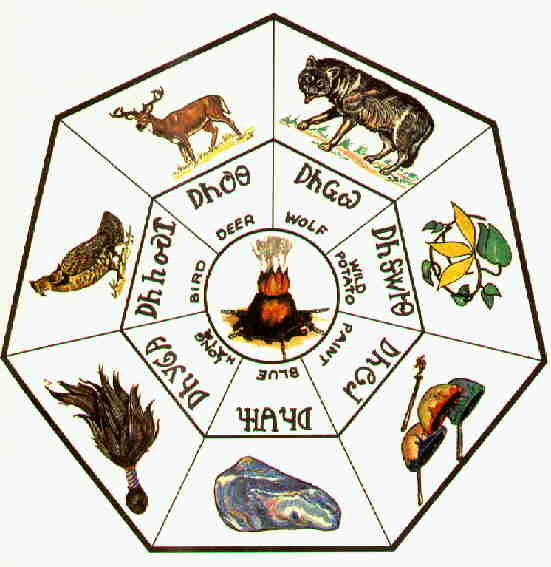
Clan affiliation was inherited through the mothers line only, membership was determined at birth, it was only natural that the child belonged to the clan of the mother. The clan provided many important functions including child care for orphans and the destitute, hospitality for visiting clan members from other towns and most important, avenging wrongs committed against the clan members before the ancient law of blood revenge was abolished in by the Cherokee National Government on September 11, 1808.
Clan structure was and still should be the basic cohesion and social infrastructure of any Cherokee nation.
Clan membership was always inherited through the mother and children belonged to their mother's clan and sat with them at the ceremonials. The children's father sat with his mother's clan. A child's uncle on his mother's side was a very important figure, and had a great deal to do with the rearing and discipline of the child. The father would be more concerned with his sister's children.
The child knew all members of the child's clan except mother and grandparents as "brothers" and "sisters". When the child grew up, he was forbidden to marry anyone in this group.
The next most important clan to the child was his father's clan. Everyone one in it was known to the child as a "father", a "father's sister" or a "grandmother". Women who married "father's" were called "step parents" if they were of a different clan than the child's, and "mothers" if they were of the child's clan. All children of "father's" were known as "brother's and sister's"
There was love and respect between children and their father, but it was the mother's brother, as a member of their own clan who had the most to say about their upbringing. Clans are/were considered close family (brothers, sisters, cousins, etc).
Clan membership was essential to one's existence within a Cherokee society because of the protection of the kinship system. A Cherokee clan determines a person's political alignment and his role in society. Kinship, through the laws of the clan, governed social relationships, dictated possible marriage partners, designated friends, designated enemies and regulated behavior through the system such as which kinsmen had to be respected and with which kinsmen one could be intimate. The clan provided many important functions including child care for orphans and the destitute, hospitality for visiting clan members from other towns.
It was also the clan who protected, supported, and looked out for its members. Clan loyalty was and still should be the strongest bond among the Cherokee.
When a clan member was visiting other nearby or distant towns, he was still considered family. His first concern was to find the members of his/her own clan for hospitality and protection and if a member of a clan needed help in any manner, his/her clan would take care of him.
The dramatic decline in clan affiliation occurred during the middle of the 20th century (1940-1969) Today on the Qualla Boundary of Western NorthCarolina there are still a few Cherokees who can identify their clanbecause it has been handed down through the generations. If the clanaffiliation is not known, it is very rare that it will be identified. The task is made very difficult because there were no record of clan membership kept on file.

Aniwayha (Wolf Clan)
The Wolf Clan is the largest and most prominent Clan, providing most of the War Chiefs. the Wolf Clan are keepers of the Wolf and the only clan that can kill a Wolf.
Anisahoni (Blue Clan)
The Blue or Panther Clan made blue medicine from a special blue plant to keep our children well. they were also known as the Wildcat Clan. the Clan color for the Anisahoni is blue.
Anigilohi (Long Hair Clan)
The Long Hair Clan are also Known as the Twister Clan, Hair Hanging Down or Wind Clan. those belonging to this Clan wore their hair in elaborate hairdos,walked in a proud and vain manner Twisting their shoulders . piece Chiefs are usually from this Clan and wore a white feather robe.
Anitsisqua (Bird Clan)
the Bird Clans are the keeper of the birds and they are our messengers. this Clan was skilled in using blowguns and snares for bird hunting.
Aniwodi (Paint Clan)
The Paint Clan made red paint and were socerers and medicine men.
Aniawi (Deer Clan)
The Deer Clan are the keepers and hunters of the Deer,
and they are fast runners.
Anigatogeioi (Wild Potato Clan)
Racoon Clan, or Blind Savannah Clan.
They were know to gather the wild potato plants in swamps along the streams to make flour or bread for food.